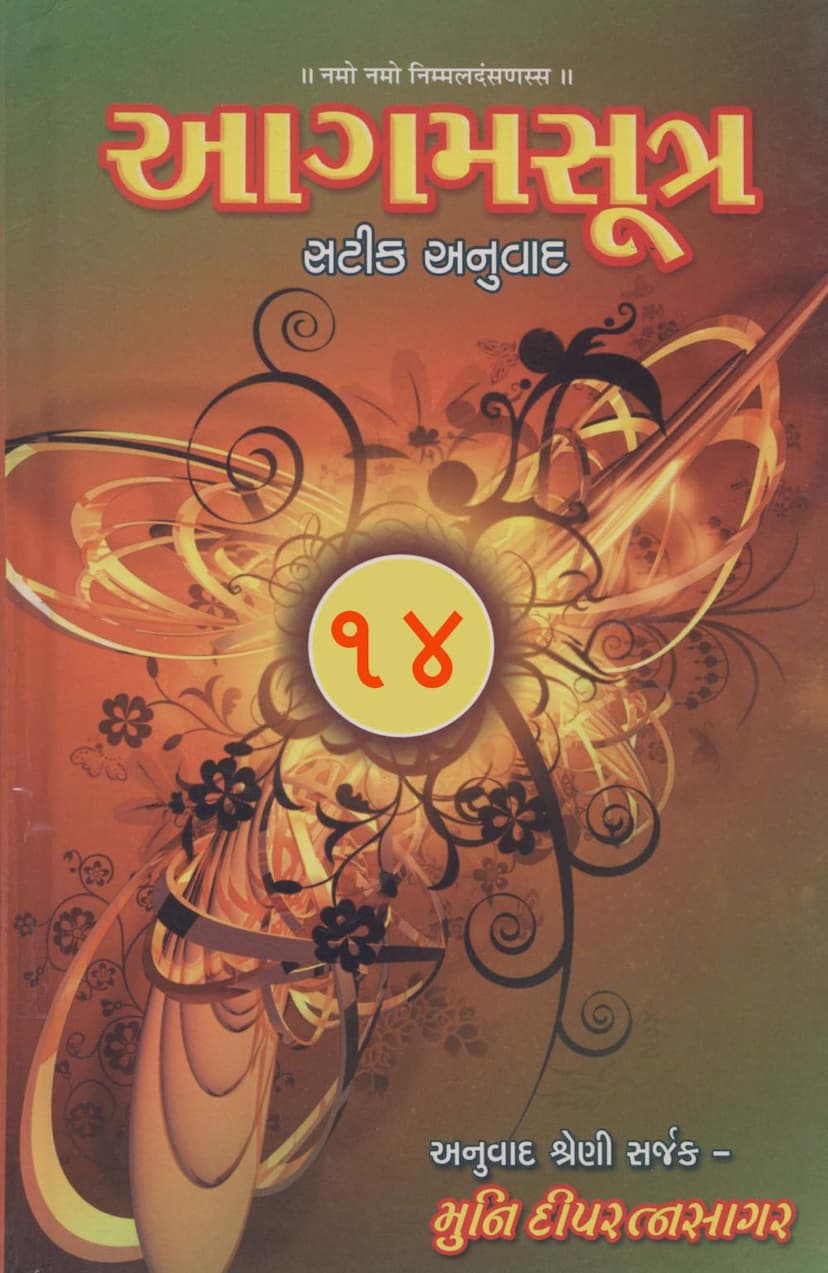Agam Satik Part 14 GnatDharmKatha Sutra Gujarati Anuwad
Added to library: September 1, 2025

Summary
This is a comprehensive summary of the Jain text "Agam Satik Part 14 GnatDharmKatha Sutra Gujarati Anuwad," authored by Dipratnasagar and Deepratnasagar, and published by Deepratnasagar. The summary is based on the provided pages, which primarily contain the title, author, publisher, catalog links, acknowledgments, donor lists, and an introduction and partial translation/commentary of the GnatDharmKatha Sutra itself.
Overall Description:
The text is the 14th part of a larger series titled "Agam Satik Anuwad," which aims to provide a commentary and translation of Jain Agamas. This specific volume focuses on the GnatDharmKatha Sutra, which is identified as the 6th Anga Sutra, specifically the 6th Sutra within the Anga category. It is also known as "Jnatadharmakatha" in Prakrit and "Jnatadharmakathan" in Sanskrit.
Key Contents of Part 14:
- Title: Agam Satik Anuwad, Bhag 14: GnatDharmKatha.
- Author: Muni Deepratnasagar (credited as the creator of the translation series).
- Publisher: Deepratnasagar.
- Content of Part 14: The volume contains the first 19 chapters (Adhyayanas) of the first Shrutskaadh (Shrutskandh-1) and the complete second Shrutskaadh (Shrutskandh-2) of the GnatDharmKatha Sutra.
- Language: The title indicates it is a Gujarati translation (Gujarati Anuwad) with commentary (Satik).
- Purpose: The series aims to make the Agamas accessible, especially to those who lack knowledge of classical Jain languages (Prakrit and Sanskrit).
Introduction and Commentary on GnatDharmKatha Sutra:
- Classification: It is the 6th Anga Sutra.
- Prakrit Name: Nathamdhamo.
- Sanskrit Name: Jnatadharmakathan.
- Structure: It has two Shrutskaadhs. The first has 19 Adhyayanas, and the second has 10 Vargos (classes), which are further divided into Adhyayanas.
- Core Subject Matter: The Sutra contains both actual narratives ("Gnyat") and illustrative examples ("Dharmakatha") presented through kalpanik (imaginary) incidents.
- The first Shrutskaadh is called "Gnyat," containing real stories and illustrative didactic examples.
- The second Shrutskaadh is called "Dharmakatha," containing actual religious narratives.
- Main Theme: The primary subject is "Kathanuyog" (narrative discourse). However, the first Shrutskaadh also provides guidance at the end of each story, which relates to "Charan-karan-anuyog" (conduct and discipline).
- Translation Methodology: The translation is described as "Teedanusaari Vivechan" (commentary based on the Vritti, or explanatory text), occasionally referencing other texts. The text explicitly states that no specific Niryukti or Churni (types of commentaries) for this Sutra were found, hence the primary commentary is from the Vritti. Where portions were omitted from the Vritti, an "X - X -" mark is used.
- Scope: The translation of this Sutra is presented in a single volume, unlike some other Agamas which are in multiple volumes. This is attributed to the relatively smaller size of the Agam.
Illustrative Content (Early Chapters):
The initial pages (from page 16 onwards) delve into the commentary and translation of the early verses of the GnatDharmKatha Sutra. This includes:
- Verses (Sutra) 1-4 and their Commentary (Vivechan):
- The text begins with Namaskar (salutations) to the omniscient Lord Mahavir and other revered figures.
- It mentions the city of Champa, its description, and the presence of a Raja Konik.
- It describes the location of a revered Chaitya (temple) outside Champa in the northeastern direction, providing detailed descriptions of its grandeur, adornments, and the surrounding environment.
- The text then introduces Arya Sudharma, the chief disciple of Lord Mahavir, highlighting his virtues, such as being omniscient, possessing true vision, being a repository of knowledge, and having attained liberation.
- The interaction between Arya Sudharma and Arya Jamboo (his disciple) is initiated, where Jamboo seeks knowledge about the structure of the Agamas and the specific content of the GnatDharmKatha Sutra.
- The initial Adhyayanas (chapters) focus on setting the scene and introducing key figures and concepts, with detailed descriptions of the city, the Chaitya, and the spiritual attainments of the monks.
- The commentary provides elaborate explanations of terms, metaphors, and religious concepts.
Acknowledgements and Donor Information:
The text includes extensive lists of individuals, families, and organizations who have contributed financially to the publication of the entire "Agam Satik Anuwad" series (parts 1 to 42). These acknowledgments highlight the significant effort and widespread support for this project. The dedication is to various revered Acharyas and Gurudevas of the Jain tradition, emphasizing the spiritual lineage and the importance of preserving these sacred texts.
Publications by Muni Deepratnasagarji:
The text also includes a list of other publications by the author/creator of the series, showcasing a vast body of work related to Jain Agamas, including:
- Original Agamas in 45 separate books.
- Gujarati translations of Agamas ("Agam Deep" series).
- Commented translations of Agamas ("Agam Satik Anuwad" series, 42 parts).
- Agam Subject Index ("Agam Vishay Darshan").
- Agam Word Dictionaries ("Agam Kosha" and "Agam Nam Kosha").
- Hindi translations of Agamas.
- Agam Katha Anuyog (collection of narratives from Agamas).
- Agam Mata Vidhi (ritual for worshipping 45 Agamas).
- Grammar literature, discourse literature, Tattvartha Sutra commentary, Sadhana literature, Ritual literature, Puja literature, Yantra literature, Jin Bhakti literature, and miscellaneous publications.
Overall Significance:
This volume, as part of a larger series, represents a significant undertaking to provide the Jain community with a comprehensive and accessible understanding of the GnatDharmKatha Sutra in Gujarati. The detailed commentary aims to clarify the profound teachings of this sacred text. The extensive acknowledgments indicate a strong commitment to this religious and scholarly endeavor. The content details within the early chapters highlight the Jain emphasis on ethical conduct, spiritual discipline, and the narratives used to impart these lessons.